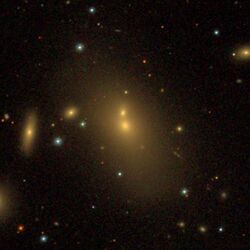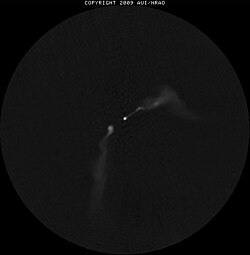Astronomy:NGC 7720
| NGC 7720 | |
|---|---|
 NGC 7720 by PanSTARRS | |
| Observation data (J2000 epoch) | |
| Constellation | Pegasus |
| Right ascension | 23h 38m 29.4s[1] |
| Declination | +27° 01′ 53″[1] |
| Redshift | 0.030221 ± 0.000047 [1] |
| Helio radial velocity | 9,060 ± 14 km/s[1] |
| Distance | 385 ± 63 Mly (118 ± 19.3 Mpc)[1] |
| Apparent magnitude (V) | 12.6[2] |
| Characteristics | |
| Type | cD;E+ pec [1] |
| Apparent size (V) | 1.6′ × 1.3′[1] |
| Notable features | Radio galaxy |
| Other designations | |
| UGC 12716, CGCG 476-091, MCG +04-55-036, 3C 465, 4C +26.64, PGC 71985[1] | |
NGC 7720 is an elliptical galaxy located in the constellation Pegasus. It is located at a distance of about 380 million light years from Earth, which, given its apparent dimensions, means that NGC 7720 is about 180,000 light years across.[1] NGC 7720 is the main galaxy of Abell 2634 galaxy cluster and is a radio galaxy. It was discovered by William Herschel on September 10, 1784.[3]
Characteristics

NGC 7720 is made of a galaxy pair that is separated by 12 arcseconds. The south galaxy is the one associated with the radio source. In the centre of the galaxy lies a dust disk is visible nearly face on. The dust mass of NGC 7720 is estimated to be between 106 to 107 M☉. There is also ionized Hα+[N II] gas emission from the disk.[4] NGC 7720A features too a dusty disk.[4]
Radio jet

NGC 7720 is a Fanaroff-Riley type I radio galaxy, and is also categorised as a wide angle tail (WAT) radio galaxy. It has two asymmetrical radio jets that emerge from the bright radio core. The core didn't exhibit variability when observed by the Very Large Array (VLA).[5] In parsec scales, the jet is one sided features relativistic motion, about 0.6 times the speed of light, and has a northwest direction.[6]
The northwest jet is the main one and forms a distorted plume about 5 arcminutes long, with a hotspot about 30 arcseconds from the core. The southeastern jet has a bright spot about 30 arcseconds from the core and then fans to a distorted plume that extends for 5 arcminutes.[6][5] In large scales the jets appear bend, maybe due to ram pressure as the galaxy moves through the intracluster medium.[7]
X-ray emission has been detected by the radio jet, indicating the contribution of synchroton mechanism to the creation of the jet. The radio plumes are regions with decreased X-ray emission.[8]
The most accepted theory for the energy source of active galactic nuclei is the presence of an accretion disk around a supermassive black hole. The mass of the black hole in the centre of NGC 7720 is estimated to be 109.28 (1.9 billion) M☉ based on stellar velocity dispersion or 109.26 (1.81 billion) M☉ based on mass of the bulge.[9]
Nearby galaxies
NGC 7720 is the dominant galaxy in Abell 2634 galaxy cluster. It is classified as a poor galaxy cluster and has a total X-ray luminosity of (1.4±0.3)×1044 erg/s, which is considered low in relation to other similar clusters. X-ray bolometric luminosity has a central peak which corresponds to NGC 7720, while excess emission is to the southwest, perpendicularly to the radio jets.[10]
About 118 galaxies lie within half degree from the centre of the cluster and are considered to be members of the cluster. Abell 2634 forms a pair with galaxy cluster Abell 2666, which is located 3 degrees to the east, but has lower redshift. Both clusters lie behind the Perseus–Pisces Supercluster. Abell 2622 lies behind Abell 2634, at about double the redshift.[11]
See also
- NGC 383 - a similar radio galaxy
References
- ↑ 1.0 1.1 1.2 1.3 1.4 1.5 1.6 1.7 1.8 "NASA/IPAC Extragalactic Database". Results for NGC 7720. http://ned.ipac.caltech.edu/cgi-bin/nph-objsearch?objname=NGC+7720. Retrieved 2023-07-07.
- ↑ "Revised NGC Data for NGC 7720". http://spider.seds.org/ngc/revngcic.cgi?NGC7720. Retrieved 25 November 2018.
- ↑ Seligman, Courtney. "NGC 7720 (= PGC 71985)". https://cseligman.com/text/atlas/ngc77.htm#7720. Retrieved 19 November 2018.
- ↑ 4.0 4.1 Martel, A. R.; Ford, H. C.; Bradley, L. D.; Tran, H. D.; Menanteau, F.; Tsvetanov, Z. I.; Illingworth, G. D.; Hartig, G. F. et al. (December 2004). "Dust and Ionized Gas in Nine Nearby Early-Type Galaxies Imaged with the Hubble Space Telescope Advanced Camera for Surveys". The Astronomical Journal 128 (6): 2758–2771. doi:10.1086/425628. Bibcode: 2004AJ....128.2758M.
- ↑ 5.0 5.1 Bempong-Manful, E; Hardcastle, M J; Birkinshaw, M; Laing, R A; Leahy, J P; Worrall, D M (21 July 2020). "A high-resolution view of the jets in 3C 465". Monthly Notices of the Royal Astronomical Society 496 (1): 676–688. doi:10.1093/mnras/staa1471.
- ↑ 6.0 6.1 Venturi, T.; Castaldini, C.; Cotton, W. D.; Feretti, L.; Giovannini, G.; Lara, L.; Marcaide, J. M.; Wehrle, A. E. (December 1995). "VLBI Observations of a Complete Sample of Radio Galaxies. VI. The Two FR I Radio Galaxies B2 0836+29 and 3C 465". The Astrophysical Journal 454: 735. doi:10.1086/176525. Bibcode: 1995ApJ...454..735V.
- ↑ Sakelliou, Irini; Merrifield, Michael R. (May 1999). "The distorted jets and gaseous environment of 3C 465". Monthly Notices of the Royal Astronomical Society 305 (2): 417–424. doi:10.1046/j.1365-8711.1999.02427.x. Bibcode: 1999MNRAS.305..417S.
- ↑ Hardcastle, M. J.; Sakelliou, I.; Worrall, D. M. (May 2005). "A Chandra and XMM-Newton study of the wide-angle tail radio galaxy 3C 465". Monthly Notices of the Royal Astronomical Society 359 (3): 1007–1021. doi:10.1111/j.1365-2966.2005.08966.x. Bibcode: 2005MNRAS.359.1007H.
- ↑ Bettoni, D.; Falomo, R.; Fasano, G.; Govoni, F. (March 2003). "The black hole mass of low redshift radiogalaxies". Astronomy & Astrophysics 399 (3): 869–878. doi:10.1051/0004-6361:20021869. Bibcode: 2003A&A...399..869B.
- ↑ Schindler, S.; Prieto, M. A. (1 November 1997). "X-ray analysis of Abell 2634 and its central galaxy 3C 465.". Astronomy and Astrophysics 327: 37–46. ISSN 0004-6361. Bibcode: 1997A&A...327...37S.
- ↑ Scodeggio, Marco; Solanes, Jose M.; Giovanelli, Ricardo; Haynes, Martha P. (May 1995). "The spatial distribution, kinematics, and dynamics of the galaxies in the region of Abell 2634 and 2666". The Astrophysical Journal 444: 41. doi:10.1086/175581. Bibcode: 1995ApJ...444...41S.
External links
- NGC 7720 on WikiSky: DSS2, SDSS, GALEX, IRAS, Hydrogen α, X-Ray, Astrophoto, Sky Map, Articles and images
- NGC 7720 on SIMBAD
 |

